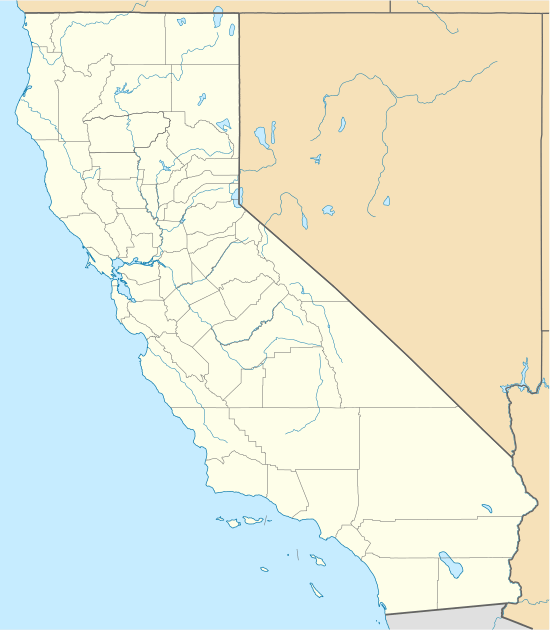Los Angeles Theatre
The Los Angeles Theatre is a 2,000-seat historic movie palace at 615 S. Broadway in the historic Broadway Theater District in Downtown Los Angeles.
Los Angeles Theatre | |
 Los Angeles Theatre, 2017 | |
   | |
| Location | 615 S. Broadway Los Angeles, California[1] |
|---|---|
| Coordinates | 34°2′47″N 118°15′9″W |
| Architect | S. Charles Lee S. Tilden Norton |
| Architectural style | French Baroque |
| Part of | Broadway Theater and Commercial District (ID79000484) |
| LAHCM No. | 225 |
| Significant dates | |
| Added to NRHP | May 9, 1979[2] |
| Designated LAHCM | August 15, 1979 |
History
This Los Angeles Theatre was constructed in late 1930 and early 1931. It was commissioned by H.L. Gumbiner, an independent film exhibitor from Chicago,[3] who also built the nearby Tower Theatre.[4] Designed by S. Charles Lee,[5] and Samuel Tilden Norton, the theater features a French Baroque interior. With its grand central staircase and gold brocade drapes, it has for many years been considered to be among the city's most lavish landmarks.[6] The opulent interior is said to have been modeled after the Hall of Mirrors in Versailles.[7] A crystal fountain stood at the head of the grand staircase, and a restaurant and a ballroom were on the lower level.[7]
Construction was completed in less than six months and cost $1.5 million.[4] Charlie Chaplin helped fund the completion so that it would be ready to open with the premiere of his film City Lights in January 1931.[8] With only 30 days to go before the scheduled premiere, the entire theater was constructed off-site and swung in, slotted between the existing buildings.[6] It was the last such movie palace built on Broadway, as the area began to feel the effects of the Depression and faced competition from Hollywood Blvd. as the "Great White Way of the West".[4] Attendance was strong through World War II, when many factory workers would see shows before and after their shifts. With the postwar suburbanization of Los Angeles, attendance declined throughout the later decades of the 20th century.
After closing its doors to the public in 1994, the Los Angeles has sat vacant for many years, although it can be rented as a venue for special events.[9] The theater is listed on the National Register of Historic Places.
The Los Angeles is used most often today as a location for filming, and is frequently seen in commercials, television shows, and feature films. It has been featured in Funny Lady (1975); New York, New York (1977); Man on the Moon (1999); Charlie's Angels (2000) and its sequel, Charlie's Angels: Full Throttle (2003); The Lords of Salem (2012); the AMC series Mad Men; among many other films. The theatre was used in the back drop on the set of The Tonight Show with Jay Leno, and seen in the music video for "Safe and Sound (Capital Cities song)" (2013), "Shake It (Metro Station song)" (2008), "Jaded" by Aerosmith (2000), "Black Swan" by BTS (2020), and "2U" by Kang Daniel (2020).
The theatre's façade and marquee design was used as the inspiration for that of the Hyperion Theatre at Disney California Adventure in Anaheim.
See also
References
- Sandra A.B. Levis. "Broadway Historic Theater District: A walking tour sponsored by the Los Angeles Conservancy" (PDF). Los Angeles Conservancy.
- "National Register Information System". National Register of Historic Places. National Park Service. April 15, 2008.
- "Los Angeles Theatre website". Dawn of the Movie Palace. Retrieved 2009-10-04.
- Kaplan, Sam Hall (1989). L.A. Follies: A Critical Look at Growth Politics & Architecture. Santa Monica, CA: Cityscape Press. p. 199. ISBN 0-9622007-0-0.
- "Los Angeles Theatre Site". Retrieved 2009-10-04.
- Lord, Rosemary (2002). Los Angeles: Then and Now. San Diego, CA: Thunder Bay Press. pp. 30–31. ISBN 1-57145-794-1.
- Samudio, Jeffrey; Lee, Portia (2001). Images of America: Los Angeles, California (trade paperback). Chicago, IL: Arcadia Publishing. pp. 106–7. ISBN 0-7385-0812-8.
- Geffner, David (January–February 2008). "Screen Gems". Westways. 100 (1): 62–65.
- "Los Angeles Theatre | Broadway Theatre Group".
External links
| Wikimedia Commons has media related to Los Angeles Theatre. |
- Los Angeles Theatre website with extensive photo gallery